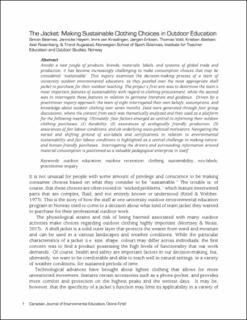| dc.contributor.author | Beames, Simon | |
| dc.contributor.author | Høyem, Jannicke | |
| dc.contributor.author | van Kraalingen, Imre | |
| dc.contributor.author | Eriksen, Jørgen Weidemann | |
| dc.contributor.author | Vold, Thomas | |
| dc.contributor.author | Abelsen, Kristian | |
| dc.contributor.author | Rosenberg, Axel | |
| dc.contributor.author | Augestad, Trond | |
| dc.date.accessioned | 2022-12-01T12:51:37Z | |
| dc.date.available | 2022-12-01T12:51:37Z | |
| dc.date.created | 2022-09-27T13:47:12Z | |
| dc.date.issued | 2022 | |
| dc.identifier.citation | Canadian Journal of Environmental Education. 2022, Artikkel 1810. | en_US |
| dc.identifier.issn | 1205-5352 | |
| dc.identifier.uri | https://hdl.handle.net/11250/3035374 | |
| dc.description | This is an open access article distributed through the Public Knowledge Project under the Creative Commons-BY License. | en_US |
| dc.description.abstract | Amidst a vast jungle of products, brands, materials, labels, and systems of global trade and production, it has become increasingly challenging to make consumption choices that may be considered “sustainable”. This inquiry examines the decision-making process of a team of university outdoor environmental educators, as they puzzled over the most appropriate shell jacket to purchase for their outdoor teaching. The project’s first aim was to determine the team’s most important features of sustainability with regard to clothing procurement, while the second was to interrogate these features in relation to germane literature and guidance. Driven by a practitioner inquiry approach, the team of eight interrogated their own beliefs, assumptions, and knowledge about outdoor clothing over seven months. Data were generated through four group discussions, where the content from each was thematically analyzed and then used as a platform for the following meeting. Ultimately, four factors emerged as central to informing their outdoor clothing purchases: (1) durability, (2) assurances of ecologically friendly production, (3) assurances of fair labour conditions, and (4) underlying socio-political motivators. Navigating the varied and shifting ground of eco-labels and certifications in relation to environmental sustainability and fair labour conditions is highlighted as a central challenge to making nature- and human-friendly purchases. Interrogating the drivers and surrounding information around material consumption is positioned as a valuable pedagogical enterprise in itself. | en_US |
| dc.language.iso | eng | en_US |
| dc.relation.uri | https://cjee.lakeheadu.ca/article/view/1810 | |
| dc.subject | bærekraft | en_US |
| dc.subject | clothing | en_US |
| dc.subject | eco-labels | en_US |
| dc.subject | outdoor education | en_US |
| dc.subject | outdoor recreation | en_US |
| dc.subject | practitioner inquiry | en_US |
| dc.subject | sustainability | en_US |
| dc.title | The Jacket: Making sustainable clothing choices in outdoor education | en_US |
| dc.type | Peer reviewed | en_US |
| dc.type | Journal article | en_US |
| dc.description.version | publishedVersion | en_US |
| dc.rights.holder | © 2022 Canadian Journal of Environmental Education | en_US |
| dc.subject.nsi | VDP::Samfunnsvitenskap: 200 | en_US |
| dc.subject.nsi | VDP::Social sciences: 200 | en_US |
| dc.source.pagenumber | 20 | en_US |
| dc.source.journal | Canadian Journal of Environmental Education | en_US |
| dc.identifier.cristin | 2055929 | |
| dc.description.localcode | Institutt for lærerutdanning og friluftslivsstudier / Department of Teacher Education and Outdoor Studies | en_US |
| dc.source.articlenumber | 1810 | en_US |
| cristin.ispublished | true | |
| cristin.fulltext | original | |
| cristin.qualitycode | 1 | |
